A QUICK LOOK at the latest developments From Stanford University Medical Center
Illustrations by Polly Becker
Photographs by Leslie Williamson, Sarah Bass, Stephen Gladfelter
![]() Freedom
from antidepressant side effects?
Freedom
from antidepressant side effects?
![]() The
nation’s first wild medicine fellow
The
nation’s first wild medicine fellow
![]() On
a roll
On
a roll
![]() Hosting
a transplanted organ with less duress
Hosting
a transplanted organ with less duress
![]() New
exec arrives to lead medical school public affairs office
New
exec arrives to lead medical school public affairs office
![]() Woof!
Woof!
![]() Developing
a women’s HIV shield
Developing
a women’s HIV shield
Freedom from antidepressant side effects?
Though antidepressants work wonders for many, some find the cure has its own set of problems that rivals those of the disease. “One mystery about antidepressants at this point is why some people get debilitating side effects and others don’t,” says associate professor of psychiatry and behavioral sciences Greer Murphy Jr., MD, PhD.
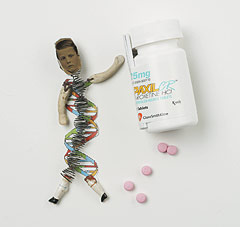 |
|
To start solving the mystery, Murphy and Alan Schatzberg, MD, the Kenneth T. Norris Jr. Professor of Psychiatry and Behavioral Sciences, looked for genetic differences that could account for why some people experience dizziness, nausea or insomnia — to name just a few of the more common side effects.
Ultimately, the work Murphy and Schatzberg are doing could lead to genetic profiling tools that would enable doctors to identify anti-depressants compatible with each patient’s particular physiology.
To get the project rolling, they analyzed DNA samples from 246 depressed patients age 65 or older who for eight weeks took either paroxetine (marketed as Paxil) or mirtazapine (marketed as Remeron).
Side effects are particularly relevant in this age group, Murphy says. Older people, for example, are more susceptible to injury from a fall caused by dizziness.
A gene at the top of their list to investigate was one that makes a liver enzyme, CYP2D6, assumed by many in medicine to be responsible for antidepressant side effects. “I can’t tell you how often this hypothesis is stated,” says Murphy. “Whole marketing campaigns have been built on whether a drug interacted with this enzyme.” To the researchers’ surprise, though, CYP2D6 appears to play no role at all. They found 40 genetic variations for the enzyme, none of which influenced the drugs’ effectiveness or side effects.
A clue is verified
The researchers checked out another gene commonly thought to play a role in causing antidepressant side effects — the gene for 5HT2a, a receptor for the neurotransmitter serotonin. They found that paroxetine patients with one version of this gene quit therapy 46 percent of the time because of side effects, almost three times as often as those with other versions. Mirtazapine works through a different route and showed no effect related to that gene.
These findings, published in the October 2003 issue of the American Journal of Psychiatry, mark just the start of the researchers’ search for genetic markers of antidepressant success.
“We feel like this is just sort of the first stab,” says Murphy. — Mitzi Baker
• Funding for this study was provided by Organon Pharmaceuticals
Inc., the manufacturer of Remeron; the National Association for Research
on Schizophrenia and Depression; the Nancy Pritzker Network and the
Department of Veterans Affairs Sierra Pacific Mental Illness Research,
Education and Clinical Center.
| ![]() Back
to Top |
Back
to Top |
The nation’s first wild medicine fellow
Art Kaminski, MD, feels happiest when he’s hiking, out in the middle of nowhere. So what’s he doing at Stanford in the thick of Silicon Valley? As usual, he’s trailblazing. Last July, when Stanford began the nation’s first fellowship in wilderness medicine, Kaminski accepted the position of first fellow.
Stanford’s program, created by Eric A. Weiss, MD, assistant professor of surgery (emergency medicine), trains fellows in all aspects of wilderness medicine, a new and growing subspecialty of emergency medicine. Weiss, a wilderness medicine pioneer, has made it his goal to prepare fellows to work in settings ranging from Himalayan peaks to Caribbean submarine canyons.
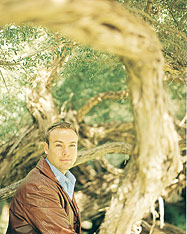 |
|
It’s a great fit for Kaminski. A Detroit native, he caught the
wilderness bug as a
kid camping with his family in Michigan’s upper peninsula. Soon he was
diving in the Great Lakes and eventually backpacking in the Amazon. guide to ‘way
out’ care
Despite Stanford’s suburban setting, Kaminski finds himself with no shortage of wilderness medicine learning experiences. His teachers include several of the field’s leaders. Among them: Weiss, an expert in wilderness improvisation and environmental extremes, gives lessons on how to provide care when few tools are available as well as treat hypothermia, heat illness, altitude illness and near drowning; Paul Auerbach, MD, editor of the textbook Wilderness Medicine, is teaching him about marine bites and stings (“everything from jellyfish, stingrays and sharks,” says Kaminski); and the division’s chief, Robert Norris, MD, expert on envenomations of the terres-trial kind, has given him the lowdown on snakebites and much else besides.
Since the fellowship also includes research work, Kaminski is writing a review of diving medicine. He’s also getting hands-on experience in Stanford’s ER.
Finally, the program includes a two-month off-site experience, designed to take advantage of Stanford’s many affiliations with wilderness medicine projects and expeditions around the world. Kaminski says planning this has been his biggest challenge so far.
Should he work with the Himalayan Rescue Association at the Mount Everest base camp? Provide medical care for a National Geographic expedition to excavate Mayan ruins in Belize? Or help develop an emergency medical services system in Mexico?
In the end, Kaminski chose the project in Mexico, based in the state
of Guanajuato in Mexico’s mountainous central region. “I’ll
get a chance to take part in important work,” he says. And if he
needs a dose of wilderness, with the Sierra de Guanajuato a few miles
away, he won’t have far to go. — Rosanne Spector
| ![]() Back
to Top |
Back
to Top |
On a roll
When first-year medical student Cheri Blauwet says she’s going to “lie low” for the summer, you have to put her comment in context.
She won’t take classes or embark on a research project. But don’t get the idea that she’s contemplating three months of inactivity. Instead, she’ll be training for the Paralympics in Athens, Greece, in September. Blauwet, an elite wheelchair marathoner, cut back her training regimen during the academic year to meet the demands of medical school. Not that her athletic performance suffered. In October 2003 she won her second consecutive New York Marathon title while setting a course record. Then in March she won the Los Angeles Marathon for the second straight year. In April, she’ll compete in the Boston Marathon.
Her family and friends have ceased to be surprised by her accomplishments.
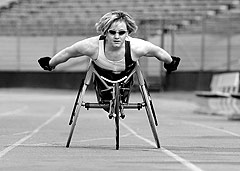 |
|
Her parents, Dale and Judy, recently traveled from their home in Iowa to Washington D.C., where the American Association of People with Disabilities presented her with a Paul G. Hearne/AAPD Leadership Award along with a $10,000 check that she turned over to the International Institute for Disability Advocacy, an organization she co-founded while earning her undergraduate degree in molecular and cellular biology at the University of Arizona. “I was listening to her and I thought, ‘Wow, she is good’ — so articulate and poised,” Judy says. “You just sit back and respect her.”
Blauwet has been paralyzed from the waist down since being run over by a tractor on her family’s farm when she was 16 months old. She got her first wheelchair at age 3, and her family urged her to be independent.
Blauwet started doing some racing in high school, but her athletic career really took off in college as she worked out with other athletes with disabilities.
In addition to her time on the track, she earned top grades in the classroom as she fed her lifelong interest in science and medicine.
“The original reason I was interested in medicine was that I wanted to work with kids with disabilities,” she says. “I saw it as a way in which I could use what I’ve learned to show kids that they can be independent, productive people.”
In March, while picking up the Hearne/AAPD award in Washington, Blauwet
spoke with congressmen and other officials about the need to change state
and national restrictions that prevent people with certain disabilities
from entering medical school. “If we’re wanting to open medical
schools to more minority groups, then we also need to look at people
with disabilities as a minority group,” she says. — Susan
Ipaktchian
| ![]() Back
to Top |
Back
to Top |
Hosting a transplanted organ with less duress
A new type of drug could offer transplant recipients a safer way to prevent organ rejection. The drug, tested at Stanford, also shows promise against autoimmune diseases.
Curtailing the immune system’s attack on transplanted organs normally requires the lifelong use of immunosuppressive drugs. Because these drugs affect many types of cells, they cause serious side effects that include high blood pressure, high cholesterol, increased rates of cancer and diabetes, damage to the nervous system and kidneys, and a weakened ability to fight off infection.
The ultimate immuno-suppressant would block the actions of the immune cells that cause organ rejection without interfering with other cells. Stanford researcher Dominic Borie, MD, PhD, says a drug he recently tested looks like it’s on the right track. The drug, called CP-690,550, inhibits a molecule thought to be present only in immune cells that lead to rejection.
Testing transplants
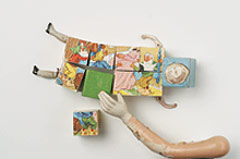 |
|
Pfizer Inc., the drug’s developer, tested the drug in mice and then worked with Borie, director of trans-plantation immunology in Stanford’s cardiothoracic surgery department, and his Stanford colleagues to take the next step toward human clinical trials: testing the drug in monkeys. The Stanford team’s experience, access to testing facilities and interest in the science clinched the collaboration.
What they found was that CP-690,550 prevents kidney transplant rejection in monkeys for longer and with fewer of the side effects seen with traditional drugs.
“We can say that this drug does as well if not better than the other immunosuppres-sive drugs we have now,” says Borie, who published the study in the Oct. 31, 2003, issue of Science. The experiments showed the drug cleanly targets immune cells that lead to rejection.
In addition to preventing organ rejection, the drug also shows promise as a therapy for quieting the overactive immune system in patients with autoimmune diseases. In studies with healthy human volunteers, Pfizer found the drug to be safe. Now the company is investigating the compound in the autoimmune disease psoriasis. If all goes well, studies in patients with kidney transplants will be next. — Mitzi Baker
• This work was funded by Pfizer. Borie’s laboratory
is supported by the Ralph and Marian C. Falk Medical Research Trust.
| ![]() Back
to Top |
Back
to Top |
New exec arrives to lead medical school public affairs office
Paul Costello, the new executive director of the Office of Communication & Public Affairs, is a veteran communication strategist with wide-ranging experience in academia, the private sector and government. During the Carter Administration he served as a press spokesman to First Lady Rosalynn Carter. He came to Stanford in January from the University of Hawaii, where he was vice president for external affairs and university relations at the 10-campus system.
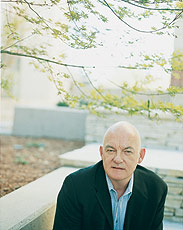 |
|
FIVE QUESTIONS FOR PAUL COSTELLO
You’ve been meeting with students and faculty talking about public advocacy. Why is it so important for health professionals to be engaged?
Costello: Physicians and scientists feel a certain sense of accomplishment — that the world understands why what they do is important. Yet, in the year 2004 there are still debates about basic scientific theories such as evolution. By nature, I am not an alarmist. But I find myself wanting to man the ramparts. A lot is at stake at this moment. It’s vital that the medical community understands this and does something about it.
You’ve had an unusually wide range of work experiences. Which of these best prepared you for your job here?
Costello: I’ve been involved in a number of presidential campaigns. They are amazing educational experiences because they force you to think strategically. You start with the end goal — winning — and work back from there. It’s the most challenging experience I’ve ever had.
What do you consider your biggest communication challenge at Stanford?
Costello: The quality and excellence of Stanford is clear. The challenge is to tell the story in new and compelling ways in a culture that is overloaded with information. I’m always pushing myself to think more creatively. It’s a cliché, I know, to say “Think outside the box.” But it’s vital. I also believe that academia is often too isolated from real life outside its boundaries. That gap has to be narrowed.
What attribute do you most value in yourself and others?
Costello: I really value curiosity in people. I know it sustains me. You can be smart, you can be brilliant, but if you don’t remain curious about all that surrounds you, what’s the use of brainpower?
What do you have in mind in terms of new initiatives?
Costello: I have a 10-point plan. No, seriously, I
think it’s a matter of building on success. Extending partnerships,
bringing fresh ideas, new approaches and different people to the table,
so to speak. Seizing the opportunities that abound in new media. We have
a tremendous platform. How do we utilize it to the maximum? That’s
the challenge. — Paul Costello & Ruthann Richter
| ![]() Back
to Top |
Back
to Top |
Woof!
The click of toenails on tile has become a familiar sound in the day hospital at Lucile Packard Children’s Hospital. But the 14 dogs who take turns roaming the unit twice a week aren’t there to receive any special medical treatment. Instead, they’re bona “fido” visitors, so to speak, with their own ID badges, dossiers and mission. They’re part of an ongoing study to determine if a furry presence can calm and soothe the sick and sometimes frightened children who come regularly to the hospital for outpatient treatments like chemotherapy and transfusions.
“It’s amazing that so much has been written about the benefits of pets in geriatric and adult settings, but we have only limited information about the effects on children,” says day hospital staff nurse Mary Delaney, RN, who is conducting the year-long study with pediatric oncologist Clare Twist, MD, and three colleagues.
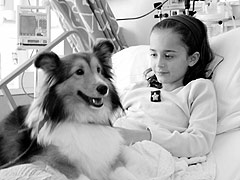 |
|
Many of the children in the day hospital are repeat visitors, returning regularly for ongoing medical treatment. It’s never fun to spend most of the day in a hospital bed but half-hour visits from the dogs and their volunteer handlers seem to help pass the time.
Since last September the researchers have enrolled 52 of what they hope will be about 100 participants.
Each child is matched up with a dog (or, a lone bunny) for two hospital visits, followed by two other visits sans animal. The children stroke, brush or simply snuggle up in bed with their new friends, each carefully screened for an easy-going nature and calm demeanor.
The children and their parents are given a questionnaire immediately before an appointment, 30 minutes after the animal has left, and then again at discharge. The results are compared with two questionnaires from visits without animals.
“We ask them questions on a sliding scale,” says Delaney, “like ‘Are you feeling nervous? If so, how much?’ ” Younger patients can circle faces with expressions that mirror their feelings.
Although the study is ongoing, anecdotal evidence is promising. Eight-year-old
Caitlin, who visits the day hospital about once a month, seems to be
a fan. “The day she knew she was going to get a dog was the first
time she ever got up early to come here,” says Caitlin’s
mother, Kelly Burns. “She told all her friends at school.”— Krista
Conger
| ![]() Back
to Top |
Back
to Top |
Developing a women’s HIV shield
Ten years ago, as he was finishing up his medical training, Peter P. Lee, MD, was struck by the fact that viruses usually can’t infect their hosts unless they first traverse a protective barrier of bacteria. Now an assistant professor in medicine, Lee specializes in cancer immunology —not infectious disease.
But the bacterial barrier is still on his mind. He asks, “Why not try to somehow harness these healthy bacteria to either block or inactivate viruses before they can get into a host?”
 |
|
Lee and his colleagues genetically engineered a strain of lactobacillus — bacteria abundant in healthy vaginal mucosal linings — to produce a protein that specifically grabs onto HIV, the virus that causes AIDS. Next they studied the supercharged bacteria in the lab and found they reduced the rate of HIV infection by at least half, as they reported in the Sept. 12, 2003, issue of Proceedings of the National Academy of Sciences.
Women at risk
The predominant mode of HIV transmission worldwide is through heterosexual contact, with the risk of transfer from male to female far greater than the reverse.
If Lee’s strategy works as well in humans as it does in cells, it would offer women a safe, inexpensive and long-lasting way to protect themselves from HIV and other viruses. The ultimate goal, Lee says, is a small vaginal suppository that a woman could insert at any time for ongoing protection. “It would be as discreet as can be,” says Lee.
Lee and professor of infectious diseases Gary Schoolnik, MD, have founded a company, Osel, to foster the use of bacteria to fight disease. Now the company is testing a lactobacillus strain’s ability to prevent diseases, like bacterial vaginosis, that arise when levels of protective bacteria are low. If this proves safe and effective, they plan to genetically modify strains to fight viruses such as herpes and eventually HIV. — Mitzi Baker
• The study published in PNAS was funded by the National Institutes of Health and by the Contraceptive Research and Development Program of Eastern Virginia Medical School.
| ![]() Back
to Top |
Back
to Top |
Comments? Contact Stanford Medicine at

